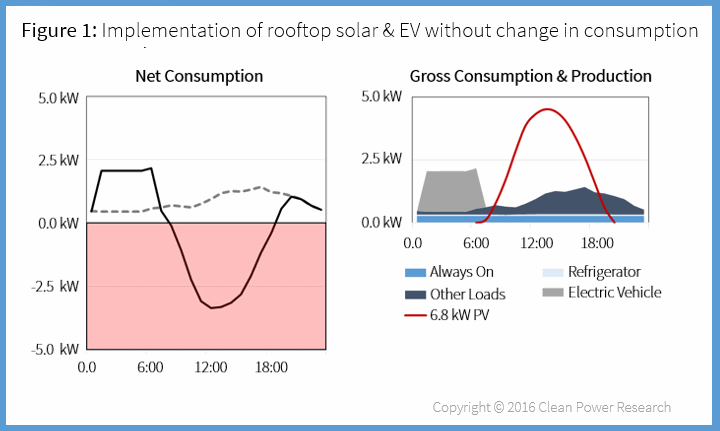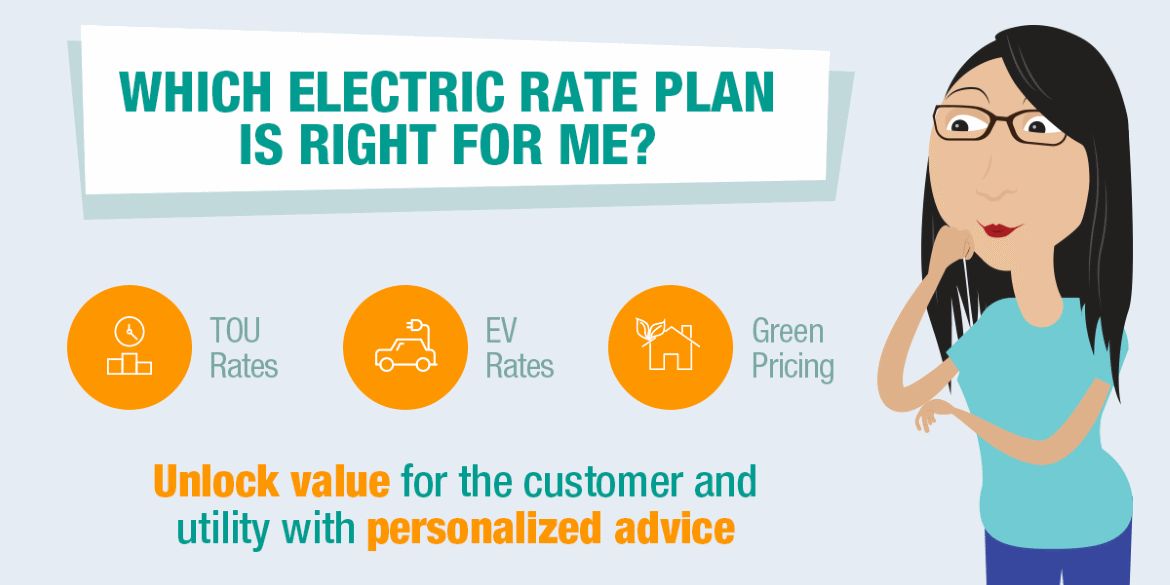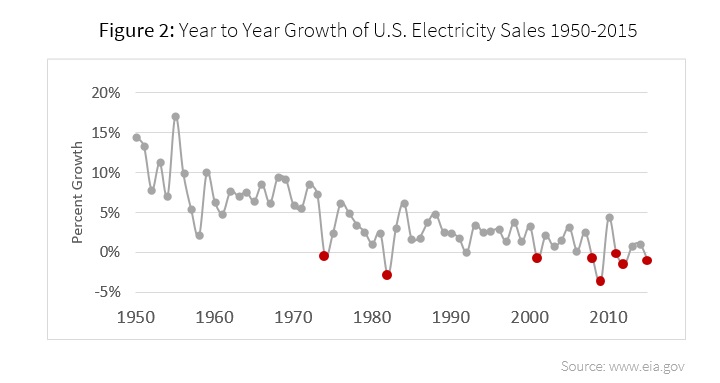The U.S. utility industry is on the precipice of a tremendous value creation opportunity. Emerging challenges such as increasing renewable generation, new regulatory pressures, the growing number of consumer energy products, and declining load are leading to evolution in rate design for mass-market customers (residential and small commercial customers).
Innovative rate designs have the potential to create significant value for the utility and its customers by solving these challenges and by building new avenues for improving customer satisfaction, but historically participation in utility programs or alternative rate plans has been low. New and unfamiliar electric rate options create the potential for confusion with customers. Great customer engagement that focuses on informing and educating customers in a personalized manner is key to unlocking rate plan potential.
DRIVERS OF RATE EVOLUTION
Let’s take a closer look at the market forces driving rate design evolution. A thorough analysis of emerging challenges and their solutions will reveal four customer scenarios requiring great utility customer engagement:
- choosing from multiple rate options
- understanding mandatory rate changes and policy changes
- discovering special utility programs (such as green pricing, or demand response options)
- and making informed energy product choices
PREPARING FOR A GREENER WORLD
The solution to date to handle non-dispatchable generation from renewables (e.g., solar and wind) has been to treat their production as negative load. Dispatchable thermal generation (e.g., natural gas turbines) is then regulated up and down to match renewable variability just as it would be for consumer demand. However, as renewable generation increases system variability will begin to exceed the responsive capabilities of controllable resources.
Net metering reform and time-based rate design offer a potential solution. Reducing compensation below retail for energy exported to the grid by rooftop solar customers encourages consuming as much solar production as possible, at the time it is produced. Time-based rates with a strong price differential between off-peak and on-peak hours encourage shifting energy use to times of excess solar production during midday, and excess wind production during late evening and at night. Some utilities are experimenting with demand response rates that allow them to control large appliances, such as air conditioning units, to address very near-term variability that dispatchable thermal generators may not be able to meet.
NEW POLICY PRESSURES
Policy changes and new regulatory pressures are supporting a shift to greater consumer choice in rate design. Deregulation in particular has been a prime driver for added consumer choice. As new electricity suppliers enter the market, utilities and retail suppliers alike are looking to varying rate designs as a way to differentiate themselves. Green pricing plans, flat rates with long term contracts, time-based rates and demand charge rates all allow customers to choose the particular service that is right for them.
Utilities may also look to rate design to help achieve policy goals such as the Clean Power Plan. Depending on the utility resource mix and the level of customer participation, estimates of emission reduction potential range from 1-6%. These projections suggest that rate design could be an extremely low cost mechanism for meeting CPP requirements.
THE INTERACTIVE CONSUMER
With more customers adopting technologies that significantly impact the grid, such as solar, battery storage, or electric vehicles, there is a growing need for rate structures to adequately communicate cost to serve and to encourage habits that benefit the grid. For customers with rooftop solar, this means shifting load earlier in the day to maximize self-consumption. For electric vehicle owners, this means charging during off-peak hours in the middle of the day or late in the evening.
Subscribers to our Solar+ Home series may recognize Figure 1, which illustrates the steep peaks and troughs that result when rooftop solar and an EV are implemented without a change in consumption patterns. Here, at least the electric vehicle charging occurs early in the morning, which has some system wide benefit at low adoption levels.

Rate options to encourage off-peak charging for electric vehicles are increasing, and the attention to rates and net metering policies for rooftop solar customers is ubiquitous. Time-based rates, demand charge rates, modifications to net metering, and value of solar tariffs all look to address the issues of cost recovery and behavior modification for interactive consumers.
DECLINING LOAD: THE COST RECOVERY PROBLEM
Growth in nationwide electricity consumption has been consistently slowing since 1950. The growth decline has quickened in recent years, and we’ve reached an inflection point crossing into the territory of flat or declining load. Between 1950-2000 there were two years in which electricity sales declined compared to the previous year (1974 & 1982). Since 2000, there have been six.
As a result, utilities are looking to new rate design methods, including increased fixed charges, time based rates or demand charge rates, to counteract flat and declining revenues for mass-market customers. Time based rates and demand charge rates both look to take advantage of the fact that in many areas while overall energy use has been flat or on the decline, peak demand has remained constant or increased.
KEYS TO GREAT UTILITY CUSTOMER ENGAGEMENT
Key to unlocking this potential value is a utility strategy that educates and advises customers in a scalable, cost-effective manner. Let’s look at a few keys to great utility customer engagement, which are central to an effective utility strategy.
- Get personal: Increasingly consumers are expecting personalized interactions from the businesses that they engage with, and for utilities this will only increase in the coming years as wide-scale adoption of DERs will further widen the range of consumer types and usage patterns. The Accenture research study “The New Energy Consumer” finds that 58% of energy consumers with smart meters want personalized advice to help reduce their bills.
- Keep it interactive: Digital communication provides a means for customers to choose when and where they interact with the utility, and also decreases the customer support burden. A win-win. And by making interaction with their utility convenient, mass-market customers are more likely to engage: the Accenture study mentioned above shows that 70% of consumers prefer a “do-it-yourself” approach to interactions.
- Make it understandable and impactful: Confused customers lead to increased customer service costs in call centers and diminishing rates of return resulting from low customer satisfaction. While innovative rate design has great potential to increase customer satisfaction (research shows that customers find time-based rates more fair than standard rates and easier to understand), mass-market utility customers are accustomed to simplistic rate design: flat, volumetric energy charges with a fixed customer charge. Simple and consistent education is required across digital channels and call centers.
- Show enabling technology: A recent report on alternative rate design from the Rocky Mountain Institute highlights enabling technologies as a critical component of successfully implementing new rate plans. Educating customers as to how enabling technologies (e.g., smart thermostats or demand control devices) can help them benefit from new time-based rates and demand charge rates will increase customer satisfaction, participation and utility benefit.
- Remain objective: When customer engagement is overlooked during rate transitions, the door is opened for outside sources to inject misinformation. Proactive engagement is an opportunity to provide objective, unbiased information and avoid negative reactions from stakeholders including customers, industry and the press. Surface your access to enormous amounts of data and fact-based information to openly and objectively guide the interactions and financial decisions.
Will utilities be able to fully realize the potential value rate evolution offers? The answer will likely depend heavily on how they choose to engage with their customers. View this great webinar from the customer engagement team at Clean Power Research to dig deeper into electric rates and four scenarios that demand personalized customer engagement.

